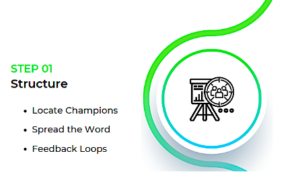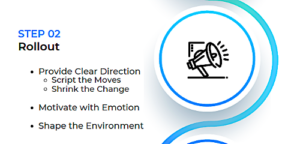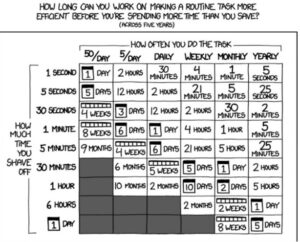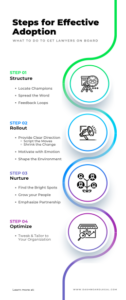How To Get Lawyers To Adopt New Tools (Part II)

This is Part II of the Adoption Series, originally published on the Legaltech Hub on March 15, 2023.
HOW TO STRUCTURE A PILOT THAT SUCCEEDS
Every pilot is unique – to each law firm, to each technology project, and to each lawyer. Seniority, practice area, and learning style all impact how new products need to be introduced and tailored to the end-user.
The goal is to overcome the inherent barriers of attorneys covered above, Skepticism, Urgency, Autonomy and Resistance – and use these characteristics to our advantage.
There are universal themes to how lawyers are trained and work, and these commonalities can be exploited to implement successful technology projects.
The good news is, in 2023, there is a wealth of knowledge about technology adoption in professional industries. Including adoption by lawyers (see Heidi Garter “Smart Collaboration”).
The data can be distilled into three phases: (I) Structure (II) Rollout and (III) Nurturing. We’ll take each in turn.
Structure
“Organize your best shot at success”
If you’ve been given the greenlight to introduce a new technology project, congratulations. That part was hard. This will be harder, and way more rewarding.
Step 1 – Locate Champions
Arguably the most important path to success, is finding quality champions. You’ll likely need at least three:
- C-suite champion, the CIO or one of his/her deputies,
- IT/KM Champion, who’s on the ground assessing and implementing new technology, and
- Lawyer champion, preferably a partner with enough political sway to get others to take the project seriously.
We’ve found that without these three champions, your project has little chance of success.
If you’re successful and the word is spreading about your solution, other champions will emerge. These second-round champions will be key for further rollout and improvement of your product and pilot product.
Step 2 – Spread The Word
As outlined in Section 1 – Lawyers ain’t got time for you. Their Urgency score is extremely high.
It’s imperative that they see and hear about the new initiative multiple times. With emails. With demos. In practice group meetings. From peers and with regular “information drips.”
As an innovation leader you’re likely very wary about bothering your lawyers. You’re extremely careful in your communications. Which is why lawyers likely think your team isn’t doing anything at all to drive innovation.
But look at the exceptions – Wilson Sonisi, Orrick, Clifford Chance and Ropes & Gray – who publish their innovation efforts and regularly engage their lawyers in innovation projects.
Do their lawyers report being spammed too much? NOPE. They report that their firm is doing innovation projects and prioritizes new technologies.
Your attorneys are getting hundreds, if not thousands of emails per week.
Your handful of technology announcements are not bothersome – they show your lawyers that you care and you’re doing something, anything to improve their lives.
Strategy: Crowd source who wants to be involved. Leverage your technology committee. You may be surprised by the level of interest.
From a basic phycological and Urgency perspective, research shows that everyone needs to hear about new technologies multiple times before they agree to use them. Your lawyers included.
If you do a single demo, then try to rollout the product, you’re setting yourself up for failure.
It takes patience, effort, and repeated touches for anything to catch on. Be courageous and follow the evidence.
Step 3 – Feedback Loops
Finally, it’s important to establish feedback loops. Regular check-in with pilot users create necessary structure to facilitate usage and success.
You can use these sessions to (i) figure out best use cases (ii) re-enforce positive uses, or (iii) just have regular intervals where people are expected to have tried it.
Setting up regular calendar for feedback is key – we suggest at least 4 times over the first few months of any project.
Rollout
“Ambitious goals, concrete behaviors”
There’s a wealth of data about successful introductions of technology products.
We’ll cover three best practices used by the most successful technology companies in the world: (1) Provide Clear Direction, (2) Motivate with Emotion and (3) Shape the Environment.
Some excellent resources here are:
- The Catalyst: How to Change Anyone’s Mind (Jonah Berger)
- Switch: How to Change Things when Change is Hard (Chip Heath)
More likely than not, you’re only going to get one shot at this (See Section 1, Lawyer’s high “Resistance” trait). So be deliberate, diligent, and find the low-hanging fruit.
Step 1 – Provide Clear Direction
The status quo feels comfortable. At work, when we’re stressed, our routines are on autopilot whether we realize it or not. But in times of change, autopilot doesn’t work, which creates uncertainty and anxiety – people default to what they know.
Any successful change requires a translation of ambiguous goals into concrete behaviors.
So as innovative teams or legaltech vendors, we need to break through the noise and suggest a good place to start. You can do this by scripting the moves and shrinking the change.
a. Script The Moves. Ambiguity is the enemy.
For a new technology product, it could be something as simple as a laminated card that says: “DON’T put updates in your MS word checklist, DO put updates this new one” or “New draft of an NDA? DON’T search iManage for precedent, DO drop it into this new system.” Then put a clearly labeled icon for the new NDA review tool on their desktop.
This may seem obvious and easy. Good. It should be. You’d be surprised by how much shelf ware is accumulated because no moves are scripted, and access is buried somewhere.
Other techniques like “Habit Stacking” have been made famous by James Clear and his book Atomic Habits. The spark notes are – find something you do habitually, like making coffee every morning, and add a new habit, like eating your oatmeal. The new habit should be obvious, so put the oatmeal next to the coffee the night before. Innovation leaders can do the same thing with new technologies.
b. Shrink The Change. Make it easy, make it obvious.
Think about cleaning a big messy house. There’s so much to do it’s intimidating, so we head to the couch and deal with it later.
But what about unloading the dishwasher? Or taking out the trash? Anyone can do that…
Pick a single scripted action that starts the process. Change is daunting and needs momentum. So shrink the change down to a single action and get your team started.
Step 2 – Motivate With Emotion
“People analyze with their heads but make decisions with their heart”
Lawyers are trained to analyze problems. In order to change behavior, you have to get them to feel something.
On an analytical level, lawyers can fully understand why a change would benefit them. But without the emotional pull, they’re unlikely to do anything at all.
Why? Because it’s easier to do things they’ve always done requires less effort. Think about going to the grocery store – you tend to buy the same brands again and again. It requires more work to figure out which new thing would be better. The same is true of lawyers. They all have the default way of doing things. Whether it’s a default app or a way of working with a colleague, it’s just easier and requires less work to stick with the old one.
To drive meaningful chance, we need evidence that makes you feel something. That hits you on an emotional level.
“Terrible things get replaced, but mediocre things stick around”
To move the needle, leaders need to demonstrate, on an emotional level, why the current way is a serious problem.
Successful tactics include a side-by-side of the old way and the new way, with a timer on the bottom.
Using an automatic email signature is a simple example. “It only takes 5 seconds to do manually, what’s the big deal?” Add it up, make it visual, and I guarantee that lawyer will spend the 3 minutes to set up the signature line.
The goal is to highlight the cost of an action to make people realize that doing nothing has a higher cost.
Leaders can also approach emotion from the opposite side – by focusing on the “promise land” destination.
Who is this future lawyer working in this amazing way? It’s the new you of course! In charge and in control.
What does this motivational future state look like? For most lawyers, it’s about being a better lawyer. Sure they want to reduce tedium and get recognized by superiors etc. but it all comes back to that one motivation: being a better lawyer. LEAN INTO IT.
If you can make the change a matter of identity, rather than consequence, you’ll find the results you’re looking for.
Backup this future state with the clear direction script we outlined in Step 1, and you’ll create magic. Don’t worry about the middle for now. It’s going to look different when you get there anyway.
Nurturing
Now that we’ve covered the first two categories of a successful implementation – structure and rollout, it’s time to nurture our users and keep them engaged.
No one can force lawyers to do anything (unless of course, the partner commands it).
Instead, leaders need to build processes to encourage and reinforce adoption. We need to shape the environment for success. Here are some tactics that work:
Find the Bright Spots / Successes
- Social proof is extremely important. Sending updates with user quotes about use-cases and successes will supercharge your adoption.
- Champions should give their express blessing to their individual teams, even if they’re not using the solution.
Grow your People
- Conduct those regular check-ins outlined in the Structuring section above.
- Create a culture of innovation and testing, with clear and obvious resources. Form an innovation committee that meets regularly. Create benchmarks and permit trial-and-error. Remember, making this change is part of their identity, not just driving for some incremental result.
Partnership!
- Show a willingness to be partner on their change journey. A commitment to continued learning about that individual lawyer’s pain points, and how tools could be improved, will help them feel involved. They’re a part of this team on a mission to improve their workflow. As Reed Hastings founder and CEO of Netflix says, “you want your employees to feel like they’re a part of the company. Not that they’re working for the company.”
Conclusion
Change isn’t an event it’s a process.
There are enormous psychological hurdles to overcome when implementing changes with attorneys. But they’re not insurmountable, and the result is worth it. Indeed, lawyers have always changed the technology they use. From law books to online legal research, hand-written notes to email etc.
We’ve found that using these concrete methods to accomplish implementation goals: clear direction, amble motivation, and a supportive environment will get you there.
Go get ‘em!




